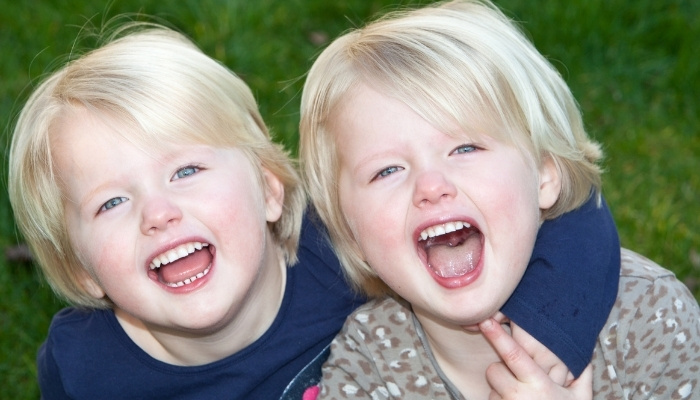Did you know that identical twins are not always completely identical? Even though they share all of their genes, there can be slight differences between them in terms of certain details.
Birthmarks are just like they sound, marks on the skin that are present at or shortly after birth. There are two major categories of birthmarks — vascular and pigmented.
A vascular birthmark occurs when blood vessels form in an irregular way. Pigmented birthmarks include brown or black moles that you are born with, café au lait spots, and blueish/purple Mongolian spots.
These birthmarks are the result of an overgrown of the skin’s pigment cells.
Researchers do not fully understand why some babies have birthmarks and others do not, but what is clear is that the development of birthmarks is influenced by both genetic and environmental factors during development in the womb.
Do identical twins have the same birthmarks? Genetic mutations in the womb can cause minor changes in appearance, such as slight differences in hair color, skin tone, and things like freckles and even birthmarks. The patterns of birthmarks, freckles, and moles on the skin are caused by random mutations and will vary between identical twins.
Identical twins are more accurately called monozygotic (MZ), meaning that they developed from a single zygote that split very early on in the pregnancy.
When the split happens, the twins begin developing with the exact same DNA, but now we know that slight changes are possible due to mutations.
If identical twins don’t have matching birthmarks and aren’t even really identical, what other ways do they differ and why? What about hair color, eye color, blood type, and even their personalities?
Differences in Identical Twins
What other kinds of differences can these genetic mutations produce in identical twins? Very rarely, genetic mutations in the womb can even change the sex of a twin producing so-called identical twins that are of different sexes.
Mutations can also cause something called disease discordance, meaning that one twin has a disease and the other does not.
This has been reported for conditions like hemophilia, multiple sclerosis, and Duchenne muscular dystrophy.
Can Identical Twins Look Different?
What about appearance? Can identical twins actually come out looking different even though they are “identical?” The answer to this is yes.
Although not as common, genetic mutations can be responsible for altering eye color, hair color, or even skin tone in monozygotic twins.
Beyond genetic mutations, external influences in the womb can affect the growth of each twin, potentially affecting height and weight.
One twin may have a better connection with the placenta and therefore get the most nutrients and potentially be larger at birth.
Once born, the twins may have different lifestyle habits. Things like smoking, drinking, nutrition, and stress can cause identical twins to look even more different as they age.
The effects of external influences on our genes is known as epigenetics.
Why Do Identical Twins Look Different as They Get Older?

Identical twins may look more and more different as they age because they are exposed to more diverse environments. Any outside influence that can be detected by the body has the potential to cause epigenetic modifications.
Some common outside influences are things such as BPA in plastics or regular exercise. Basically, it’s nature vs nurture.
If one twin is more active and has good nutrition and the other twin drinks, smokes, and eats poorly, they are likely to look more and more different even though they share 100% of their DNA.
How To Tell Newborn Twins Apart
If you are expecting twins, one worry you might have is how you will tell them apart after birth. Here are a few ways to make sure that you know which one is which before you learn their little personality nuances.
- Look for birthmarks – Birthmarks can be a simple way to tell your identical twins apart. Note which child has a birthmark and where.
- Make a mark – You might try painting a toenail of one of the twins.
- Use the diaper – If nail polish seems too difficult, consider writing the letter of their first name on their diaper.
- Dress them in certain colors – Try putting one twin in pastels and the other in primary colors or even one in stripes and the other in solids.
- Positions – When taking pictures, try always posing one on the left and the other on the right.
Facts About Identical Twins
Identical twins are fascinating, and here are just a few of the many reasons why.
- Mirror Image Twins – About 25 percent of identical twins develop directly facing each other, meaning they become exact reflections of one another.
- Small Differences – Identical twins are not actually identical.
- Different Fingerprints – Identical twins don’t have the same fingerprints.
- Twins for Science – Studying identical twins can provide powerful data for scientific research.
- Change Over Time – Identical twins become less and less alike with age.
Related Questions:
Do Identical Twins Have the Same Blood Type?
The short answer here is yes, identical twins share the same blood type with very few exceptions.
It is important to remember that small changes in DNA that can happen in the womb could potentially lead to two identical twins having different blood types, although this is rarely the case.
Do Identical Twins Have the Same Personality?
If you have ever met a pair of identical twins, you probably recognize that despite being born with matching DNA, they are different people with their own unique personalities.
Twins accumulate epigenetic changes as they age, making them more different over time.
Even though identical twins are born with the same genes, they develop different personalities based on how they interact with their environment, and this life experience, in turn, probably changes their genes.
Conclusion
So now you know. Identical doesn’t always mean identical, and twins even become more different over time. If you are lucky enough to have identical twins, you have a front-row seat to the effects of nature versus nurture.
Watching how these two amazing little people born of the same DNA develop unique personalities is truly fascinating.
Mom of three (including identical twin boys), wife, and owner of Parents Wonder. This is my place to share my journey as a mother and the helpful insights I learn along the way.

